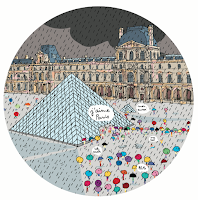C'est les vacances de Pâques. Les étudiants et les professeurs profitent de cette pause pour reprendre le souffle.
Mais il y a en pas mal qui font des petites balades et même des projets linguistiques entre écoles pays européens.
Et Paris est toujours une ville de rêve pour beaucoup de monde. Alors, je vous parle un peu de la tour Eiffel, si vous pensez faire bientôt une visite d'études. Et je vous propose des applications pour préparer e suivre la visite.
Tour Eiffel en dessin 1889
photo: Sipa
La tour Eiffel fête ce mardi ses 126 ans. Un anniversaire d’autant plus symbolique que la 'Dame de Fer', érigée à l'occasion de l'exposition universelle de 1889, mal-aimée de ses contemporains du XIXe, aurait dû être démolie après 20 ans d’existence.
Google même, célèbre cet anniversaire, et il publie sur sa page d'accueil un doodle en dessins d'époque de construction de la tour Eiffel.
Durant deux ans, deux mois et cinq jours, 250 ouvriers s'attèlent à la construction de cet édifice en fer puddlé. Et le 31 mars 1889, la fameuse 'dame de fer' fut inaugurée.
Un peu d'histoire?
Pour rappel, celle-ci, construite par Gustave Eiffel en seulement un peu plus de deux ans, culmine dans le 7e arrondissement de Paris à 324 mètres de hauteur.
Elle a été inaugurée le 31 mars 1889 à l'occasion de l'Exposition universelle de Paris.
La Tour Eiffel devrait être détruite comme la plupart des palais construits pour l'exposition, mais Gustave Eiffel la sauva grâce à la science. Dès le début, Gustave Eiffel a conçu sa tour comme un poste de télécommunications télégraphiques.
"C'est l'installation des premières antennes de radio sur la tour qui a permis d'abord des liaisons avec le Panthéon (situé à quelques kilomètres), puis avec l'est de la France, et après l'Afrique du Nord. Cela a permis à la Tour de trouver une raison d'être, un usage stratégique, militaire, qui a conforté son existence.
Pendant la Guerre de 14, elle a joué un rôle stratégique en décryptant des messages d'offensives par exemple, qui ont pu être déjouées grâce à cela", explique le spécialiste de l’architecture Bertrand Lemoine.
Pour savoir un peu plus visitez le blog des élèves : La tour Eiffel, la connaissez-vous?
Repeinture de la tour Eiffel en 1924
French National Library, public domaine
Après quelques décennies, la tour Eiffel a fini par se faire adopter par le Tout-Paris. Même Guy de Maupassant, qui l'a longtemps décrite comme un "squelette géant et disgracieux", s'y rendait régulièrement pour y dîner.
"Il avait cette réponse extraordinaire qui était de dire que c'était le seul endroit de Paris d'où on ne la voyait pas", confie Frédéric Seitz, auteur de "La tour Eiffel : cent ans de sollicitude".
A partir de 1958, des projecteurs éclairent la tour Eiffel d'en bas depuis le Champ-de-Mars. On se souvient aussi du compteur lumineux qui décomptait les jours avant l'an 2000. Dernière innovation, lorsque la tour s'habille de 20 000 ampoules qui la font pétiller 10 minutes toutes les heures durant la nuit.
La Tour Eiffel
Michel Donnance OCTP
Pas possible d'imaginer Paris sans sa tour Eiffel. Et pourtant, à l'époque, de nombreuses voix s'élevèrent contre son édification. "Chandelier creux" ou "squelette disgracieux" furent quelques-unes des 'amabilités' qui lui ont été adressées.
Les artistes la traitaient même de "monstrueuse" cette tour qui "défigure Paris". Mais comme le Centre Pompidou ou la Pyramide du Louvre, au Musée du Louvre, la tour finira à convaincre les esprits les plus récalcitrants et enchanter les esprits plus innovateurs.
Éducation:
Bon, je vous propose donc une appli si vous pensez partir à la découverte de la tour Eiffel avec vos élèves.
Oui, la tour Eiffel a des aspirations pédagogiques. Et elle vous porpose des applis que vos étudiants vont vraiment aimer.
screenshot appli tour Eiffel
Avec ces applications officielles de la tour Eiffel, vous élèves auront dans sa poche et après entre les mains toutes les informations essentielles pour préparer leur visite et pour vous rendre facilement au monument en suivant le parcours qui vous est conseillé.
L’application propose également :
- Plans,
- Météo,
- Actualités
- Photos et vidéos
- Tarifs et horaires,
screenshot appli tour Eiffel
Mais Google Play a aussi une appli, enfinm pas gratuite, mais que sert davantage les principes pédagogiques.
- 1h de visite commentée : suivez le guide à travers 27 étapes originales pour tout connaître de la Tour
- Panorama Très Haute Définition : prenez de la hauteur pour admirer Paris et identifier plus de 70 bâtiments célèbres, de jour comme de nuit, grâce au zoom x20
screenshot appli tour Eiffel
- 70 images en diaporama : examinez les documents d'époque et les photos inédites d'hier à aujourd'hui
- 4 plans interactifs : parcourez les étages en un clin d'oeil et construisez votre parcours à la carte
- Horaires, tarifs,... : retrouvez l'essentiel des informations pratiques.
Note : aucune connexion à Internet n'est requise après l'installation : tout est embarqué dans votre téléphone.
Versions: Français ; English.
Prix : 2,69€
screenshot appli La tour Eiffel a des ailes
Il y a aussi une autre appli pour les plus petits, de chez Nathan, mais un but différent : Premières lectures. Elle s'appelle La Tour Eiffel a des ailes. On peut la trouver sur iTunes
Cette appli a été conçue pour les enfants qui apprennent à lire. Elle s’appuie sur la collection Premières Lectures de Nathan: des histoires testées par des enseignants qui respectent les apprentissages progressifs de l’enfant
Chaque histoire est écrite avec un vocabulaire mixte, plus simple au niveau des bulles et plus recherché dans le corps de texte. A lire sur iTunes
Autres ressources en ligne:
LA Tour Eifflel vous offre aussi un site qui pourra rendre votre visite plus appétissante.
Quelques pensées:
Tous les élèves, dès l'âge de l'école primaire aiment le numérique. Et on peut rendre les cours plus motivants ayant des outils numériques.
Moi, je crois que l'appli GooglePlay est plus complète que celle d'iTunes. Mais révisez les deux et décidez ce qui s'adapte mieux à vos élèves et au niveau d'apprentissage.
Pour l'enseignement primaire, l'appli La tour Eiffel a des ailes est délicieuse. Bien sûr que ça ne doit pas être q'une partie de vos propos pédagogiques.
Les visites écoles et les projets linguistique au collège et lycée sont une excellente expérience pédagogique pour les jeunes étudiants.
Ils dévelopent les connaissances en plusieurs disciplines et améliorent leurs compétences linguistiques et culturelles.
Pour la tour Eiffel, les visites écoles, les jeunes et les plus petits peuvent s'amuser pendant la visite et jouer avec la tour.
Mais ils peuvent aussi perfectionner les langues (disciplines) puisque les applis se présentent en français et anglais.
Les professeurs de langues peuvent bien profiter pour les faire écouter et suivre la langues qu'ils sont en train d'apprendre.
Et pourquoi pas se faire accompagner d'un professeur d'histoire-géo? Ça fera un intéressant projet axé sur plusieurs thèmes.
Les enseignants du primaire ont leur coin ici pour organiser la visite, et des supports des pédagogiques.
À visiter 'le coin la tour Eiffel des enfants' ici
LA Tour Eifflel vous offre aussi un site qui pourra rendre votre visite plus appétissante.
dessin : Soledad Bravi
Quelques pensées:
Tous les élèves, dès l'âge de l'école primaire aiment le numérique. Et on peut rendre les cours plus motivants ayant des outils numériques.
Moi, je crois que l'appli GooglePlay est plus complète que celle d'iTunes. Mais révisez les deux et décidez ce qui s'adapte mieux à vos élèves et au niveau d'apprentissage.
Pour l'enseignement primaire, l'appli La tour Eiffel a des ailes est délicieuse. Bien sûr que ça ne doit pas être q'une partie de vos propos pédagogiques.
Les visites écoles et les projets linguistique au collège et lycée sont une excellente expérience pédagogique pour les jeunes étudiants.
Ils dévelopent les connaissances en plusieurs disciplines et améliorent leurs compétences linguistiques et culturelles.
Pour la tour Eiffel, les visites écoles, les jeunes et les plus petits peuvent s'amuser pendant la visite et jouer avec la tour.
Mais ils peuvent aussi perfectionner les langues (disciplines) puisque les applis se présentent en français et anglais.
Les professeurs de langues peuvent bien profiter pour les faire écouter et suivre la langues qu'ils sont en train d'apprendre.
Et pourquoi pas se faire accompagner d'un professeur d'histoire-géo? Ça fera un intéressant projet axé sur plusieurs thèmes.
Les enseignants du primaire ont leur coin ici pour organiser la visite, et des supports des pédagogiques.
À visiter 'le coin la tour Eiffel des enfants' ici
Sur les cartes postales, c'est elle qui, inévitablement, représente Paris et plus largement la France. Cet édifice, 126 ans plus tard, est trône fièrement au cœur de Paris et constitue l'un des monuments les plus visités au monde.
GSouto
31.03.2015
Copyright © 2015G-Souto'sBlog, gsouto-digitalteacher.blogspot.com®
Applis éducation : on visite la Tour Eiffel ? by G-Souto is licensed under a Creative Commons Attribution-NonCommercial-NoDerivatives 4.0 International License.




















